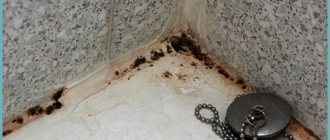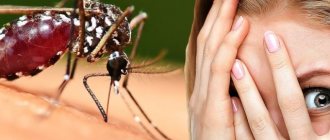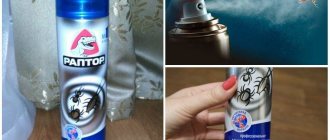Today, more than 2,000 varieties of fleas are known; a variety of species can annoy a dog, including those that are considered primarily cat parasites. Moreover, these insects choose not only a pet as their target; they can also be transmitted from an animal to a person. However, to successfully combat them, identification of a specific variety is not required, since the methods of destroying parasites are not fundamentally different.
Fleas not only cause discomfort to the dog with constant bites, but the danger also lies in the spread of various infectious diseases by these parasites. Most often, pets are susceptible to attack by common fleas, which look like this:
- The body size is quite small, the length rarely exceeds 0.5 mm.
- The color of the insect can vary from a red tint to dark brown or virtually black. Parasites that are white or gray in color or have a clear or translucent warmth are often mistaken for fleas when they are not. In most cases, these are lice or lice, which are fought with completely different methods.
- Well-developed hind limbs, which make fleas very easy to identify. This type of insect needs them to make rapid jumps, which are used to quickly move over distances that are many times greater than the size of the flea's body.
Signs and Symptoms of Fleas in Dogs
The reproduction process of fleas is very rapid, and they do not lay eggs, which are easy to detect. An adult flea, moving around a dog, shoots eggs in different directions, and they land not only on the fur, but also on many objects around.
The following signs may indicate that your pet is being bothered by these parasites:
- Disturbance of the animal's sleep; the dog often wakes up and moves around in search of another place to rest.
- Restless behavior, which can be expressed in the form of sudden movements, atypical arching of the body, or freezing in certain positions for a period of time.
- The pet begins to gnaw furiously on any part of its body.
- Violent scratching of certain areas of the body. Scratching, which is caused by insect bites, is easily distinguished from harmless scratching: it is much more violent, longer and is done with unusually fast movements of the paws.
Folk methods of disposal
Today, in specialized stores there is a wide range of different drugs and devices that allow you to destroy fleas that have settled on a dog. However, many people, for various reasons, prefer to abandon store-bought remedies, opting for folk remedies.
This is mainly due to the lack of toxic agents that would be used to treat animal hair. Below are the most common and popular folk remedies to combat this type of parasite:
- The use of wormwood is the most famous technique, since people have long known how much most insects cannot stand its smell. You will need to prepare a decoction from this plant; both dried and fresh leaves are suitable for this. If the dried version is used, then only 20 grams will be enough, but for a fresh plant the volume doubles. Wormwood is placed in a container into which several glasses of water are poured, which then must be brought to a boil. After this, the broth must be given time to cool, and then begin to be rubbed into various parts of the animal’s body. The main advantage of this method is the safety of wormwood, so it can even be used to treat puppies.
- Combing wool is one of the most common and simplest folk methods of getting rid of parasites. It is recommended to use combs or combs with a large number of fine teeth. Ideal for very young puppies who are not recommended to be treated with strong smelling natural products or toxic chemicals. The main disadvantage of this method is the fact that such combing can get rid of parasites, but at the same time does not provide absolutely no protection from them in the future.
- Garlic has an extremely unpleasant aroma for any insects, which immediately repels them, forcing them to look for other habitats. You will need to grind about 2-3 garlic cloves through a meat grinder, and then pour the resulting substance with 3-4 glasses of plain water. The mixture sits overnight, after which it becomes suitable for treating your pet. It is important to remember that garlic is poisonous for dogs; if it enters the digestive system, it can cause not only disruption of the corresponding processes and poisoning, but also the death of the animal if the dose was too large. Therefore, it is necessary to apply the mixture in such places that the dog does not have the opportunity to lick it off, for example, on some areas of the back or withers. To increase the effectiveness of the product, you can add a certain amount of brewer's yeast to it.
- Pine sawdust is another very effective flea repellent. It is clear that no one will feed them to their dogs or rub them into their fur, but sawdust can be sprinkled on the floor in a kennel or other places where the animal spends a significant amount of time. This will help get rid of insects in your pet’s usual habitats, which will reduce the likelihood of relapses. To prevent the dog from dragging the sawdust all over the house or the area around it, you can make a pillow out of it.
- You can prepare a herbal decoction for which tansy, wormwood and eucalyptus are mixed in equal proportions. This combination of plants is considered highly effective, largely due to the fact that the mixture will act not only on fleas, but also on other types of parasites, such as bedbugs or mosquitoes.
- Another effective recipe is to prepare a decoction, the main ingredients of which are geranium and lavender leaves. The uniqueness of such a mixture lies in the fact that it will emit an odor that is adequately perceived by both humans and animals, but is not tolerated by different types of insects, which will allow you to get rid of them in the shortest possible time.
Industrial means for removing fleas
At the moment, there is a huge range of products that can be used to remove fleas from a dog. However, for all their effectiveness, each of them has only a temporary effect, because these parasites are widespread everywhere. As soon as the treatment ends, the flea may appear again. Therefore, you need to know what you can do to prevent an invasion, how to quickly get rid of insects, and how to maintain the result in the future.
Shampoos
Shampoos help remove fleas from dogs only if there are a minimum number of them; as the insects multiply, this type of treatment completely loses its effectiveness. Products containing insecticides, such as permethrin, help get rid of parasites. However, this component can cause an allergic reaction, the signs of which are: excessive salivation and vomiting.
There are also products for disinfestation of dogs with natural ingredients. Plant extracts have an antipruritic, anti-inflammatory, healing effect, and keep your pet's hair in a healthy condition. After applying flea shampoo to the dog, carefully distribute it over the body (avoiding contact with the eyes, nose and mouth), leave for a while (according to the instructions), and rinse. After drying, it is recommended to comb the dog with a fine-toothed comb.
Among the most popular shampoos for fleas on dogs are: Mr. Bruno, Bars, Phytoelite.
Drops
You can quickly get rid of blood-sucking parasites from your four-legged friend at home using drops. This option is more effective than the previous one, and therefore enjoys deserved popularity. The effect of the contents of the bottle lasts for about a month (provided that the instructions are followed).
The drops are applied to the dog’s skin in a place that is inaccessible to licking (most often the scruff of the neck). The active ingredient is toxic to bloodsuckers; it penetrates the animal's epidermis and bloodstream, resulting in the elimination of insects. However, before removing fleas from a dog with drops, you need to consult a veterinarian, since the active ingredients have side effects and contraindications.
Treatment of dogs for parasites
If you use products prepared according to folk recipes and intended for external application to the fur, you should not forget about the general rules for treating your pet:
- Most products, especially those based on garlic, must be applied to hard-to-reach places to avoid possible poisoning.
- All animals kept together must be treated. After this, they must be isolated from each other for several days.
- It is not recommended to pet the animal for one or several days after processing the fur.
- Before full treatment, you can apply a small amount of the product to the animal’s fur and watch the reaction to make sure there is no allergy to any of its components.
Tips and warnings
When treating dogs with your favorite folk remedies, it is recommended to adhere to the following tips so that the procedure is safe and does not entail any negative consequences:
- Most methods eliminate parasites, but provide little protection against them in the future, especially if the animal lives in the countryside. Therefore, to increase efficiency, systematic and combined use of different techniques is necessary. Violation of the established regime can lead to the reappearance of fleas in the fur.
- The bedding, kennel and other objects with which the dog has contact must also be carefully processed. This is necessary even if no parasites are noticed on them, since eggs will most likely be laid there.
- All procedures for eliminating insects are best carried out outdoors, since in most cases they are aimed only at scaring away parasites from the dog. After treating the fur, fleas will begin to actively jump off the animal and can spread throughout the house, after which they will probably turn their attention to people.
What else should I treat to get rid of it?
| Name | Terms of use |
| Table or sea salt | The benefit of salt is that this substance destroys the chitinous membrane of insects The method of control is to bathe the dog in salt water.
|
| Camphor, table vinegar and cologne | This is a destructive mixture for any parasites. Combine the components in equal proportions. For better use, pour the resulting liquid into a spray bottle. Spray onto the animal's fur. Wait 10-15 minutes, do not let the animal lick itself. Then rinse well. |
| Boric acid | The fighting mechanism is that the substance disrupts the integrity of chitin, fleas die without their shell. The powder can be scattered around the house or diluted in water and sprayed onto the dog's fur. The product is completely safe for the animal. |
Reviews about the use of folk remedies
Below are reviews from people who have already used various folk remedies to remove fleas from their pets, and are now ready to share their impressions of such methods:
- Zinaida: “I live in a village near Dmitrov, it is virtually impossible to buy special means for killing parasites from animals, and fleas appear on the dog periodically, since she spends a significant amount of time on the street. I use only one way to remove them: I prepare a decoction of wormwood, then soak a rag in it and wipe the dog with it. I carry out this procedure once every two weeks, after which I boldly let the dog into the house, without fear that he will bring parasites on himself; they disappear almost immediately.”
- Tatyana: “As a matter of principle, I don’t buy any chemical products for removing fleas. I only used them once; I really didn’t like the pungent smell, which can easily cause poisoning. As a remedy for parasites, I use exclusively a decoction, for the preparation of which I mix tansy and wormwood; both plants can be easily collected independently. Once a month I bathe both a dog and a cat in this mixture, after which you can forget about fleas for a long time, while the product is completely natural and you don’t have to worry about your pets.”
- Nikolai: “Before, I always used dog sprays and drops against fleas, they were effective, but for the sake of experiment, last year I decided to try treating the dog with a mixture made from garlic at the dacha. I read a lot about this method and its dangers, so I was a little worried, but I took all precautions. I didn’t expect this myself, but the effect is no worse than from store-bought drugs. Now I’ve decided to stop using them, because I think it’s better not to poison your pet with toxic substances again, although there have been no negative precedents before.”
Is there a flea vaccination?
Many owners would like to have their pet vaccinated against fleas. As such, there is no flea vaccine. However, grafting is often referred to as insecticide injection. The injection acts like drops, but the effect can last up to six months. The mechanism of action of the vaccination is as follows: when bitten by an insect, it receives a dose of a toxic substance that causes a disturbance in the parasite’s nervous system, and then its death.
The positive aspects of flea injections for dogs include the simplicity of the method. To protect your pet from bloodsuckers, only a single injection is required. In addition, the possibility of the drug entering the animal’s gastrointestinal tract is completely eliminated, which means there is no risk of poisoning. An additional advantage is that the product is available in different versions, providing for the treatment of dogs of different ages and colors.
Not all dogs can receive flea injections. Injections are contraindicated for puppies under 2 months of age, weak pets, and people with allergies. You cannot vaccinate yourself - this must be done by a veterinarian after a preliminary examination of the dog. The most commonly used anti-flea vaccinations are: Lufenuron, Eprimek, Ivermectin.











